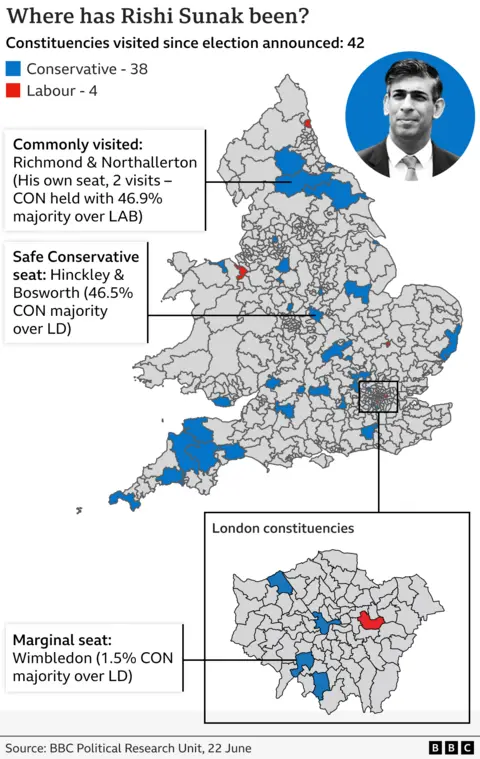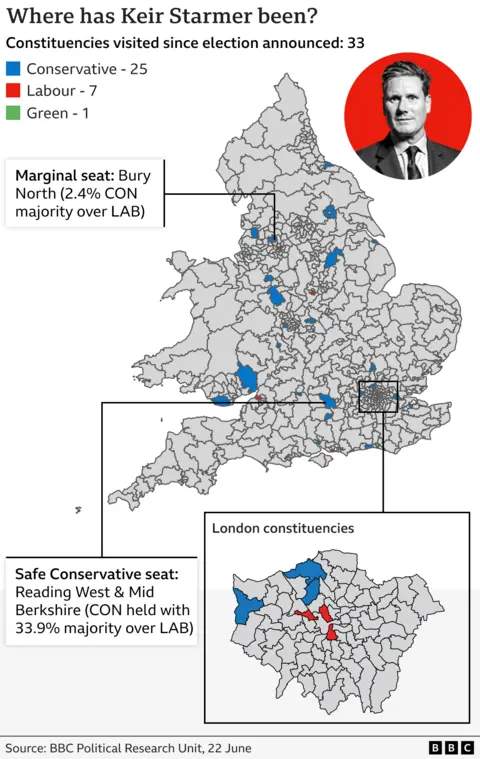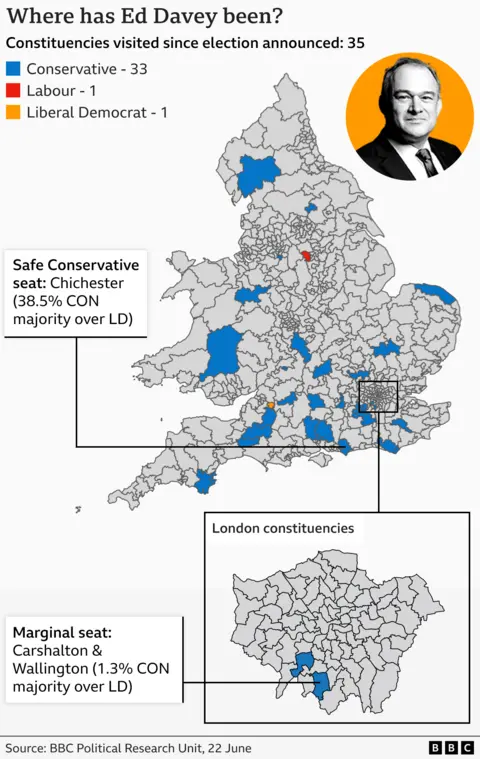By Oscar Bentley and Lauren Tavriger, BBC Political Research Unit
 Getty Images
Getty ImagesThe Conservatives are fighting a highly-defensive general election campaign, with Rishi Sunak visiting areas his party has won comfortably in the past, BBC analysis shows.
The prime minister has campaigned in constituencies where the Tories won big in the last election, with notional majorities of more than 20,000.
In recent days, they have included Grantham and Bourne (22,393 or 46% of votes cast) and Torridge and Tavistock (22,899 or 42%).
The Labour and Liberal Democrat leaders have also campaigned in areas where the Conservatives won in 2019 – again often by a sizable margin.
Leaders visit areas for a range of reasons – but campaign visits are a strong indication of where the parties believe they should be focusing their attention.

The BBC has collated the movements of the three leaders since the start of the year.
The data here focuses on visits in England and Wales that have taken place since the election was called on 22 May, up until 22 June. Our data is based on visits attended by the media and others reported online by various sources. It is not a complete list because leaders may have chosen to attend events privately.
We have used notional results to understand how safe seats are compared with 2019. The constituency map has changed since 2019 – so seats are not directly comparable. Notional results are based on calculating what the results would have been with the new constituency map in 2019.
We have presented the figures for each seat as the majority of the winning party followed by the percentage of the vote this represents.

The clearest pattern identified in our analysis is that all three parties are focusing on Tory-held areas.
The Conservatives won the 2019 election comfortably, so it was always probable that this would be the case.
But some 90% of Mr Sunak’s visits analysed by the BBC since the election was called, were to areas won by the Tories in 2019 – illustrating a highly defensive campaign. This continues a pattern seen since the start of the year.
What will concern some Conservatives is how many traditionally-safe seats Mr Sunak has spent valuable time campaigning in.
They include the likes of Suffolk Coastal (18,355 or 35% of votes cast), South Northamptonshire (23,671 or 42%), Melksham and Devizes (17,028 or 31%) and Swindon North (13,250 or 28%).
This doesn’t mean the Conservatives fear losing them all. But it is significant they have decided to send the prime minister to these places in the run-up to polling day.
Not only does it suggest they feel the need to shore up support, it means Mr Sunak cannot spend as much time in other more marginal areas.

At the same time, 76% of the visits by Sir Keir Starmer since the campaign began, and totalled by the BBC, were won by the Conservatives in 2019.
That includes a number with sizable notional majorities – Reading West and Mid Berkshire, Bassetlaw, Nuneaton, Thurrock and Monmouthshire.
Again, Labour is not necessarily expecting to win all of these. But again it is significant the leader is spending time campaigning in these areas during the campaign.
If Labour did win these seats, it would suggest a sizable majority on 4 July.

The Liberal Democrats are also targeting Conservative-held seats. They have been the almost-exclusive focus of Ed Davey since the election was called. From the 35 visits he has made, 33 – or a massive 94% – were to areas the Tories won at the last general election.
Again, many of those areas visited had sizable Conservative majorities in 2019. They include Chichester, North Norfolk, Eastleigh and South Devon.
We have not included Scotland or the SNP leader John Swinney in this data because the Scottish parties often run their own campaign visits. That makes it harder to compare the data on visits during the campaign.
We have also decided not to include Northern Ireland because it is dominated by its own political parties.
Additional reporting: Sarah Glatte, Sophie Van Brugen, Callum May, Nick Eardley.






